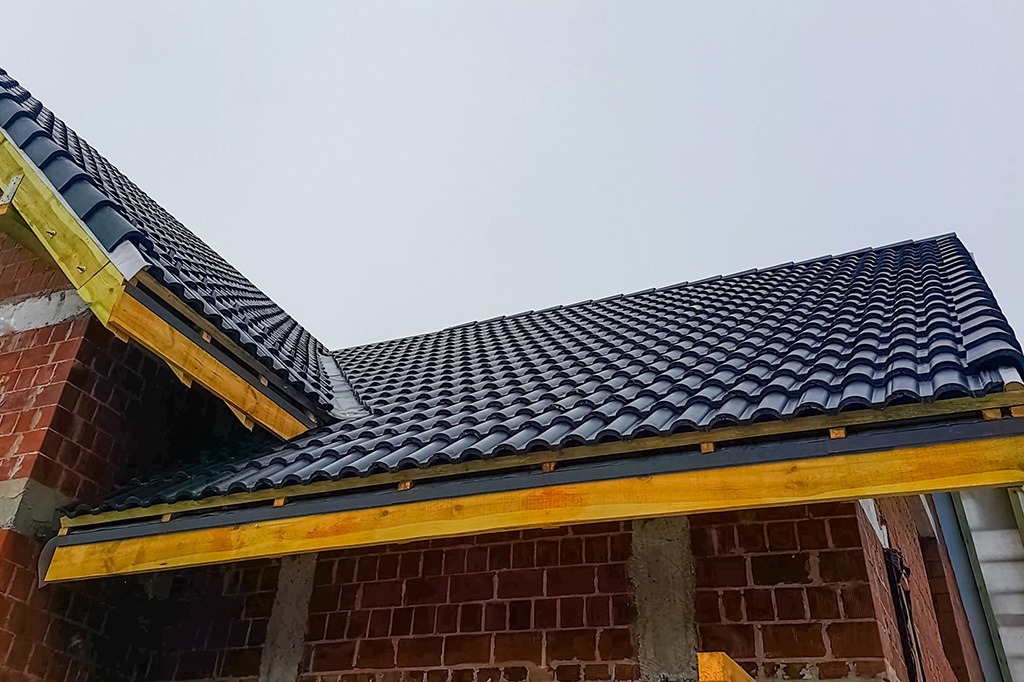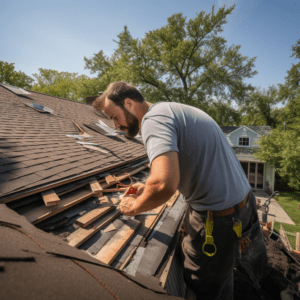This article explores a range of unique roofing solutions that have emerged in recent years. By juxtaposing innovative materials, creative designs, and eco-friendly options, this piece aims to inform readers about alternative and cutting-edge approaches to roofing. Through the use of high-tech innovations, unconventional techniques, and customized designs, this article provides practical insights for individuals seeking distinctive solutions for their roofing needs. By showcasing the advancements in the field, this article seeks to evoke curiosity and interest among its audience.
Key Takeaways
- Innovative materials such as cool roofing, synthetic slate, metal roofs, and composite roofing offer enhanced durability, energy efficiency, and environmental sustainability.
- Unconventional roof shapes like butterfly roofs, sawtooth roofs, and folded plate roofs provide unique architectural designs and functional advantages such as increased natural light, improved ventilation, and enhanced rainwater collection capabilities.
- Eco-friendly roofing options include solar panel integration, green roofing materials, rainwater harvesting systems, and living roofs, which promote sustainability and reduce the environmental impact of buildings.
- High-tech roofing innovations like solar panel-integrated roofing systems, self-healing membranes, and advanced insulation materials improve durability, functionality, and energy efficiency.
Innovative Materials for Roofing
Innovative materials for roofing have become increasingly popular due to their ability to enhance energy efficiency and provide long-lasting durability. These materials offer a range of benefits that make them highly desirable options for both residential and commercial buildings.
One such material is cool roofing, which is designed to reflect sunlight and reduce heat absorption. This helps to lower cooling costs during hot summer months, making it an energy-efficient choice. Cool roofing materials typically have high solar reflectance and thermal emittance properties, ensuring effective heat reduction.
Another innovative roofing material is synthetic slate, which offers the appearance of traditional slate but with added benefits. Synthetic slate is made from a combination of recycled materials, making it an eco-friendly option. It also boasts superior durability compared to natural slate, as it is resistant to cracking, fading, and weathering.
Metal roofs are another popular choice for their longevity and sustainability. They are often made from recyclable materials such as steel or aluminum and can last up to 50 years with minimal maintenance. Metal roofs are fire-resistant, lightweight, and can withstand extreme weather conditions.
Overall, these innovative roofing materials provide practical solutions for enhancing energy efficiency while maintaining long-lasting durability. Their growing popularity reflects the increasing demand for sustainable building practices in today’s construction industry.
Creative Roof Designs
This discussion will focus on the use of innovative materials for roofs, exploring how these unique roofing solutions can enhance the overall performance and aesthetics of a building. Additionally, we will examine the impact of unconventional roof shapes in terms of functionality and visual appeal. Lastly, we will discuss the importance of customized roof aesthetics and how they contribute to the architectural design and individuality of a structure. By delving into these key points, we hope to provide valuable insights into creating distinctive and high-performing roofs in various architectural contexts.
Innovative Materials for Roofs
One approach to enhancing roofing solutions involves the utilization of novel materials specifically designed for this purpose. These innovative materials offer a range of benefits, including improved durability, energy efficiency, and environmental sustainability. For instance, some manufacturers have developed composite roofing materials that combine the strength of traditional materials like asphalt with the lightweight properties of polymers. This not only increases their resistance to weathering and impacts but also reduces the structural load on buildings. Additionally, new coatings and membranes are being developed that enhance waterproofing capabilities and reflect solar radiation, leading to reduced energy consumption for cooling purposes. Furthermore, advancements in nanotechnology have enabled the development of self-cleaning roof tiles that repel dirt and pollutants, improving aesthetics while reducing maintenance requirements. Overall, these innovative materials contribute to more efficient and sustainable roofing solutions for a wide range of applications.
Unconventional Roof Shapes
Unconventional roof shapes have gained attention in recent years due to their potential to offer unique architectural designs and functional advantages. These unconventional roof shapes deviate from the traditional gable or hip roofs commonly seen in residential and commercial buildings. Examples of unconventional roof shapes include butterfly roofs, sawtooth roofs, and folded plate roofs. Butterfly roofs have two slopes that meet at a valley, resembling the wings of a butterfly. Sawtooth roofs consist of a series of ridges with vertical glass panels or windows between them, allowing for natural light penetration. Folded plate roofs feature multiple folds that create a sculptural effect while providing structural stability. These unconventional roof shapes not only add visual interest to buildings but also offer practical benefits such as increased natural light, improved ventilation, and enhanced rainwater collection capabilities. Architects and designers are increasingly incorporating these innovative roof shapes into their projects to create distinctive and functional spaces for occupants.
Customized Roof Aesthetics
Customized roof aesthetics have become a focal point in architectural design, as architects and designers aim to create visually appealing buildings that reflect the unique characteristics of their clients’ preferences. To achieve this, various elements are taken into consideration. The shape and form of the roof play a significant role in defining the overall aesthetic appeal of a building. Architects can incorporate different angles, slopes, and curves to create visually striking designs. Additionally, materials such as metal, glass, or natural elements like wood or stone can be used to further enhance the desired aesthetic effect. Color choices also contribute to the customized appearance of roofs. By selecting colors that complement or contrast with the building’s facade or surroundings, architects can create dynamic visual compositions. Overall, customized roof aesthetics offer opportunities for creativity and individuality in architectural design while still ensuring functionality and durability.
Eco-Friendly Roofing Options
This discussion will focus on eco-friendly roofing options, specifically solar panel integration, green roofing materials, and rainwater harvesting systems. Solar panel integration involves the installation of photovoltaic panels on rooftops to harness sunlight and convert it into electricity. Green roofing materials refer to sustainable and environmentally friendly options such as recycled shingles or tiles made from renewable resources. Rainwater harvesting systems collect and store rainwater for various uses like irrigation or flushing toilets, reducing dependence on municipal water sources. These solutions offer practical ways to promote sustainability and reduce the environmental impact of buildings.
Solar Panel Integration
Solar panel integration into roofing systems has become an increasingly popular method for harnessing solar energy. This innovative approach involves incorporating solar panels directly into the structure of a building’s roof, allowing for efficient utilization of available space and maximizing energy generation potential. By integrating solar panels into the roofing system, homeowners and businesses can benefit from reduced reliance on traditional power sources, lower electricity bills, and decreased carbon emissions. The integration process typically involves mounting the solar panels onto specially designed brackets or frames that are securely attached to the roof surface. These systems require careful consideration of factors such as load-bearing capacity, orientation, and shading analysis to ensure optimal performance. Additionally, proper installation and maintenance are essential to ensure long-term durability and efficiency of the integrated solar panel system. Overall, solar panel integration provides a practical solution for generating clean and renewable energy while utilizing existing roof space efficiently.
Green Roofing Materials
Green roofing materials offer a sustainable alternative for constructing roofs that prioritize energy efficiency and environmental conservation. These materials are designed to reduce the carbon footprint of buildings and provide numerous benefits to both the structure and the environment. One popular type of green roofing material is a living roof, which consists of vegetation planted on top of a waterproof membrane. This type of roof helps regulate indoor temperature, reduces stormwater runoff, and improves air quality by absorbing pollutants. Another option is recycled or reclaimed roofing materials, such as recycled metal or rubber shingles made from old tires. These materials not only reduce waste but also have excellent durability and fire resistance properties. Additionally, green roofing materials can be designed to accommodate solar panels or other renewable energy systems, further increasing the sustainability of the building.
Rainwater Harvesting Systems
Rainwater harvesting systems are effective in collecting and storing rainwater for various non-potable uses, such as irrigation, toilet flushing, and laundry. These systems typically consist of collection surfaces like rooftops or paved areas, gutters or pipes to channel the water into storage tanks or cisterns, filtration systems to remove debris and contaminants, and distribution networks to transport the harvested water to the desired locations. Rainwater can be stored underground or aboveground depending on available space and local regulations. The collected water can then be used for a range of applications that do not require potable water, reducing dependency on municipal water supplies and lowering overall demand. Rainwater harvesting systems offer an environmentally sustainable solution by harnessing a free resource while also reducing stormwater runoff and alleviating strain on public utilities during periods of high demand.
Alternative Roofing Solutions
An increasing demand for environmentally friendly and sustainable building materials has led to the exploration of alternative roofing solutions. Traditional roofing materials such as asphalt shingles and concrete tiles are known for their negative environmental impacts, including high energy consumption during manufacturing and disposal issues. As a result, researchers and manufacturers have been working towards developing roofing alternatives that are more eco-friendly.
One such alternative is the use of recycled materials in roofing products. Recycled rubber, plastic, and metal can be used to create durable and weather-resistant roof coverings. These materials not only reduce waste by repurposing discarded items but also require less energy to produce compared to traditional options.
Another approach gaining traction is the installation of green roofs or rooftop gardens. Green roofs consist of vegetation planted on top of a waterproof membrane. They provide numerous benefits like improved insulation, reduced stormwater runoff, and increased biodiversity in urban areas.
Furthermore, solar panels integrated into rooftops offer an innovative solution for generating renewable energy on-site. Solar roof tiles or photovoltaic modules can be seamlessly incorporated into the roof design while harnessing sunlight to generate electricity.
High-Tech Roofing Innovations
High-tech roofing innovations have emerged as a result of advancements in materials and technology. These innovations aim to improve the durability, efficiency, and functionality of roofs while also addressing environmental concerns. One such innovation is the development of solar panel-integrated roofing systems. These systems incorporate photovoltaic cells into traditional roofing materials, allowing them to generate electricity from sunlight. This not only helps reduce energy consumption but also enables homeowners to harness renewable energy sources.
Another high-tech innovation is the use of green roofs or living roofs. Green roofs are designed with vegetation layers that provide insulation, absorb rainwater, and mitigate heat island effects in urban areas. They can be used for both residential and commercial buildings, providing numerous benefits such as improved air quality and reduced stormwater runoff.
Furthermore, advancements in roofing materials have led to the development of self-healing membranes. These membranes contain special polymers that can repair small punctures or tears by themselves, increasing their lifespan and reducing maintenance costs.
Unique Roofing Techniques
Innovative approaches to roofing have emerged, employing unconventional methods and materials to enhance the performance and aesthetics of roofs. One unique technique is green roofing, which involves the installation of vegetation on rooftops. Green roofs provide numerous benefits such as improved stormwater management, reduction in urban heat island effect, enhanced air quality and energy efficiency. Another unconventional method is the use of solar shingles or photovoltaic (PV) roof tiles. These shingles are designed to look like traditional roofing materials but generate electricity from sunlight. Solar shingles can be integrated seamlessly into the roof surface, making them visually appealing while also contributing to renewable energy production.
Additionally, there are new advancements in lightweight roofing systems that offer durability and ease of installation. For instance, synthetic slate and shake materials mimic the appearance of natural slate or wood shakes but are much lighter in weight. This makes them easier to handle during installation while maintaining a high level of durability.
Furthermore, some innovative techniques focus on improving insulation and energy efficiency. Cool roofs utilize reflective coatings or materials with high solar reflectance to reduce heat absorption by reflecting sunlight back into the atmosphere instead of transferring it into the building below. This helps lower cooling costs in warmer climates.
Overall, these unique roofing techniques contribute to sustainable practices by enhancing environmental performance and reducing energy consumption while still providing practical solutions for protecting buildings from weather elements.
Unconventional Roofing Materials
Unconventional materials, such as recycled rubber or plastic, have been employed in roofing systems to provide durability and resistance against weather elements. These materials offer unique benefits that make them viable alternatives to traditional roofing materials.
Recycled rubber is a common choice for unconventional roofing solutions due to its durability and resistance to extreme weather conditions. Rubber roofs are made from recycled tires and other rubber products, which helps divert waste from landfills. In addition, rubber roofs have excellent flexibility, allowing them to expand and contract with changing temperatures without cracking or splitting. This makes them ideal for regions with fluctuating climate patterns.
Plastic roofing materials, on the other hand, are lightweight yet strong enough to withstand harsh weather conditions. They are often made from high-density polyethylene (HDPE), a durable plastic material that provides resistance against UV radiation and moisture damage. Plastic roofs can be manufactured in various forms such as corrugated panels or shingles, offering versatility in design options.
These unconventional roofing materials also contribute to energy efficiency by reflecting sunlight and reducing heat absorption into buildings. This results in lower cooling costs during hot summers.
Cutting-Edge Roofing Solutions
Cutting-edge advancements in the field of roofing have introduced new materials and technologies that enhance durability, weather resistance, and energy efficiency. One such advancement is the development of cool roofs. Cool roofs are designed to reflect more sunlight and absorb less heat than traditional roofs, resulting in lower surface temperatures. This helps to reduce cooling costs during hot summers and mitigates the urban heat island effect in densely populated areas. Cool roof coatings can be applied to existing roofs or integrated into new roofing systems.
Another innovative solution is the use of green roofs or living roofs. These roofs are covered with vegetation, providing a range of benefits including improved insulation, reduced stormwater runoff, increased biodiversity, and enhanced aesthetic appeal. Green roofs can help regulate indoor temperatures by reducing heat transfer through the roof structure.
Advancements in solar technology have also revolutionized roofing solutions. Solar panels can now be seamlessly integrated into roofing materials such as shingles or tiles, allowing for efficient electricity generation while maintaining a visually appealing appearance.
Furthermore, advancements in nanotechnology have led to the development of self-cleaning roof coatings that repel dirt and prevent algae growth. These coatings utilize nano-sized particles that create a hydrophobic surface which prevents water from adhering to the roof.
Customized Roofing Designs
The design of roofs can be tailored to meet specific needs and requirements, allowing for customization based on factors such as climate, building aesthetics, and energy efficiency. Customized roofing designs offer practical solutions that address the unique challenges faced by different buildings. For instance, in areas with heavy rainfall or snowfall, a steeper roof pitch may be recommended to prevent water accumulation and facilitate drainage. On the other hand, in regions with hot climates, roofs can be designed to include ventilation systems or reflective materials to mitigate heat buildup.
Building aesthetics also play a significant role in customized roofing designs. Architects and designers strive to create visually appealing structures by incorporating unique shapes, colors, and materials into the roof design. This not only enhances the overall appearance of the building but also ensures harmony with its surroundings.
Energy efficiency is another crucial consideration when customizing roof designs. Energy-efficient roofing materials such as solar panels or green roofs can be incorporated to harness renewable energy sources or promote sustainable practices.




